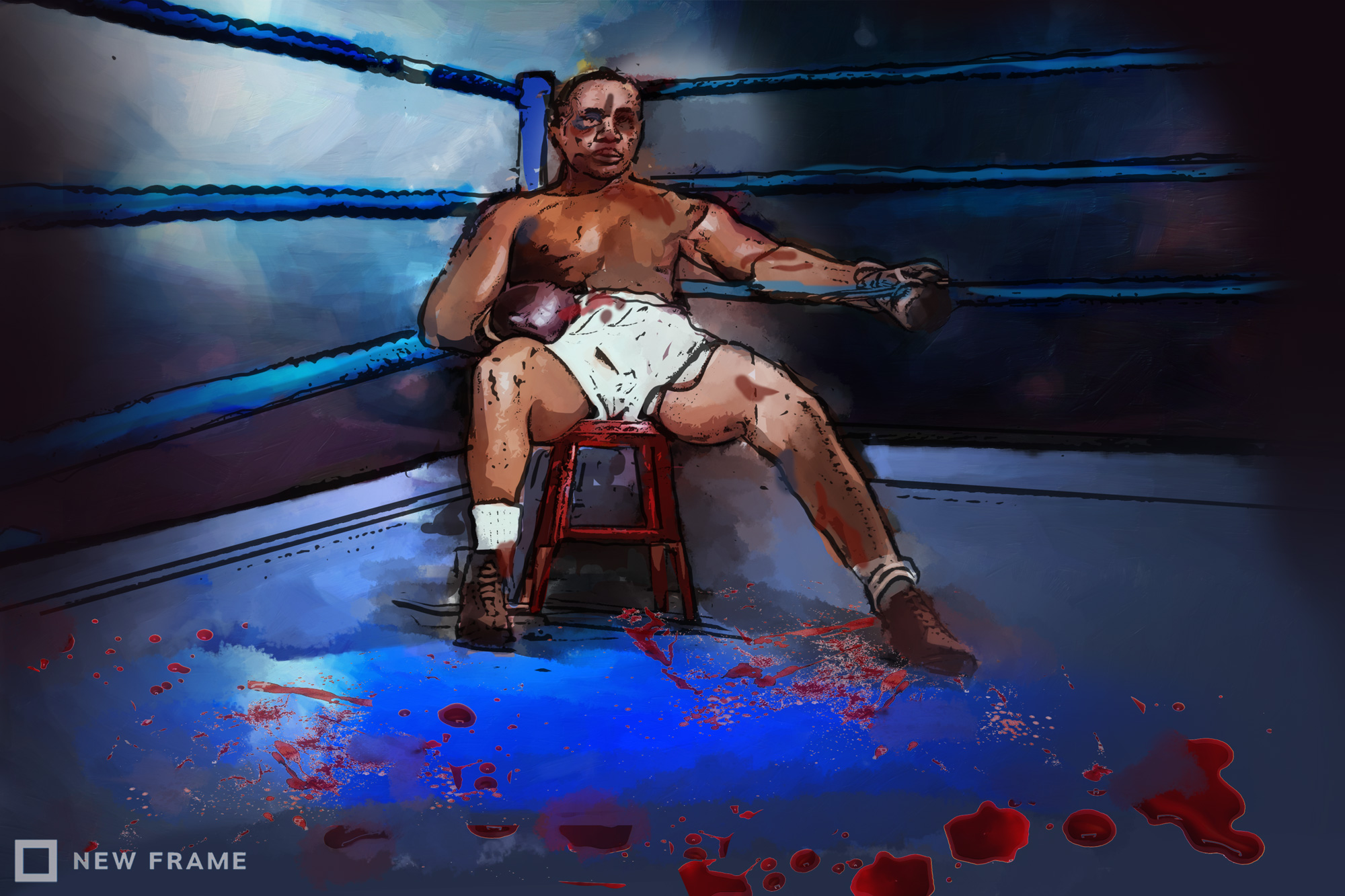The dark, deadly side of boxing
The sweet science that is pugilism has many admirers, including some of the most talented people to have lived. But it also has deaths, too many of them.
Author:
27 September 2019

Six boxers’ names featured on the poster for an event at Westridge Tennis Stadium in Durban on 14 June 1988. Four are still alive.
One of the two who have died, Simon Skosana, sank low enough in his later years to have to sell his South African bantamweight title belt. So far, so boxing. Unusually for a fighter, though, he died of natural causes in hospital. He was 51 years old.
But he lived almost twice as long as the other dead boxer on that poster, who was poleaxed by a right to the neck in the 10th and last round of his super-lightweight fight against Kenny Vice. A doctor was called to the ring but couldn’t stop the fighter from dwindling into a coma. Three days later, the machines suspending him between life and death were turned off.
He came with a superb pugilistic pedigree – his father, uncle and cousin were all South African champions – and was one of the most arrestingly exciting fighters around. So his sluggish performance that night surprised many.
It emerged that he had been in a car accident four days earlier, the consequence of fiddling with the tape deck while driving to the weigh-in. He hit his head on the windscreen. Reports said the impact had rendered him unconscious. The Sunday Times newspaper reported that he had ducked through the ropes despite not having been granted the medical clearance to do so.
‘Kill a man and get paid’
Brian Baronet’s name still haunts South African boxing circles, and his is far from the only one. In 1995, it was estimated that 500 men had died because of injuries suffered in rings around the world, 22 in 1953 alone. And that was since 1884, when the Marquis of Queensberry rules were adopted to rescue boxing from a fate worse than bear-baiting.
Baronet’s death was followed by 27 more, by the time heavyweight champion Deontay Wilder said in May this year: “This is not a gentleman’s sport. This is the only sport where you can kill a man and get paid for it at the same time – it’s legal. So why not use my right to do so?”
Two answers to that chilling question were delivered in less than a week in July. Maxim “Mad Max” Dadashev left the ring on a stretcher, blood flooding his brain, after his trainer, Buddy McGirt, threw in the towel 11 rounds into his junior-welterweight bout against Subriel Matias in National Harbour, Maryland, in the United States on 19 July. Four days later, Dadashev was dead, like Baronet, at the age of 28. He had reeled off 13 consecutive victories, 12 of them inside the distance, before his fateful 14th fight.
“It just makes you realise what type of sport we’re in, man,” McGirt told US sports channel ESPN. “He did everything right in training, no problems, no nothing.
Related article:
“My mind is, like, really running crazy right now. Like, what could I have done differently? But at the end of the day, everything was fine [in training]. He seemed okay, he was ready. But it’s the sport that we’re in. It just takes one punch, man.”
The day after what became Dadashev’s last fight, Hugo Alfredo “Dinamita” Santillan earned a split draw after 10 rounds against Eduardo Javier Abreu in Buenos Aires, Argentina. He collapsed as the result was being read out.
“Upon admission to the hospital, he had successive kidney failure and he did not come out of his coma,” said Dr Graciela Olocco of Hospital de Agudos San Felipe. “He had swelling of his brain and he never recovered consciousness. The swelling continued to worsen and it affected the functioning of the rest of his organs.”
At 12.35am on the second day after he was admitted, in the wake of surgery for a blood clot on the brain, Santillan’s heart could no longer keep him alive. He was 23 years old.
Deadly, but financially rewarding
We get it, boxing kills. Not as wantonly as war, smoking or drunk driving, but often enough to question how, in 2019, it can be accepted as a sport fit for civilisation?
A powerful argument for why that should change bobs and weaves between the results of a research article by Matthew R Potter, Ashley J Snyder and Gary A Smith. The authors are attached to the Center for Injury Research and Policy at the Ohio State University College of Medicine in Columbus and the article was published in the April 2011 edition of the American Journal of Preventive Medicine.
“An estimated 165 602 individuals sustained boxing injuries that resulted in a visit to a US hospital emergency department from 1990 through 2008. An average of 8 716 injuries occurred annually, and there was a statistically significant increase in the annual number of injuries during the 19-year-study period. The rate of injury was 12.7 per 1 000 participants. Those injured were predominantly male (90.9%).
Related article:
“The most common diagnosis was fracture (27.5%), and the most common body regions injured were the hand (33%) and head and neck (22.5%). Punching bag-related injuries accounted for 36.8% of boxing injuries. The percentage of injuries that were concussions/closed head injuries in the group aged 12-17 years (8.9%) was similar to that in the group aged 18-24 years (8.1%) and the group aged 25-34 years (8.5%).”
Despite all this and plenty of other similarly damning evidence, boxing will not be banned. Doing so would be as effective at rooting it out as outlawing sex work has been for stopping people from paying and being paid for sex.
Besides, as former heavyweight champion Larry Holmes said: “All fighters are prostitutes and all promoters are pimps.” Where there are boxers, there are people who make a living out of exploiting them. And there is much to exploit.
The May 2015 welterweight showdown between Floyd Mayweather Jr and Manny Pacquiao generated $600 million, $430 million of it in pay-per-view revenue. No single event in world sport can touch those numbers.
Sweet science, bitter taste
The paradox is that no sport rivals boxing as the most viable legal avenue out of poverty for those who are too black, in social and economic terms, for even football to better their lot. Holmes also said: “It’s hard being black. You ever been black? I was black once – when I was poor.”
That makes boxing real and relevant enough to arrest the most creative minds. Artist Pablo Picasso was an ardent fan. He was photographed squaring up with his son, Claude, and painted boxers and even a self-portrait in a puncher’s pose. Novelists Jack London, Ernest Hemingway and Norman Mailer jabbed their pencils in peons to pugilism, while journalist AJ Liebling combined being a bona fide gourmand with his passion for boxing well enough to cover both for no less than The New Yorker magazine, and to produce The Sweet Science, perhaps the best book on sport yet written.
And it’s not all about men. Author Joyce Carol Oates gets it better than most, regardless of gender, and has the perspicacity to say why: “Boxing is about being hit rather more than it is about hitting, just as it is about feeling pain, if not devastating psychological paralysis, more than it is about winning.”
Related article:
Mixed martial arts (MMA) is routinely held up as the No. 1 contender for boxing’s title as the world champion of combat sports. MMA is indeed uglier and may well be more popular at the moment. But it will never win this fight, not least because no one has been killed in its cause since its most high-profile event, the Ultimate Fighting Championship, was founded in November 1993.
One reason is that MMA uses four-ounce gloves that are smaller and less padded than those boxers wear. So more punches fly in the octagon than in the ring, but they cause less damage to opponents because MMA fighters would break their own hands if they unleashed their blows with a boxer’s power.
“How can you enjoy so brutal a sport, people sometimes ask me,” Oates wrote. “Or pointedly don’t ask. And it’s too complex to answer. In any case I don’t ‘enjoy’ boxing in the usual sense of the word, and never have; boxing isn’t invariably ‘brutal’; and I don’t think of it as a ‘sport’.”
Damn straight, and an unassailable counter-argument to Liverpool’s beloved manager Bill Shankly holding that: “Some people think football is a matter of life and death. I don’t like that attitude. I can assure them it is much more serious than that.”
All good. Except that boxing, alarmingly often, really is about life and death. Even when it isn’t, it needs injury to decide winners and losers. Boxing doesn’t need death, but it doesn’t mind it.



